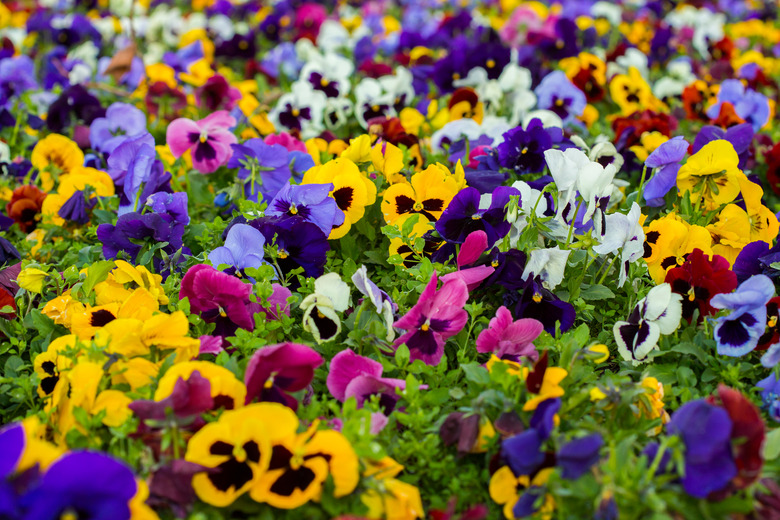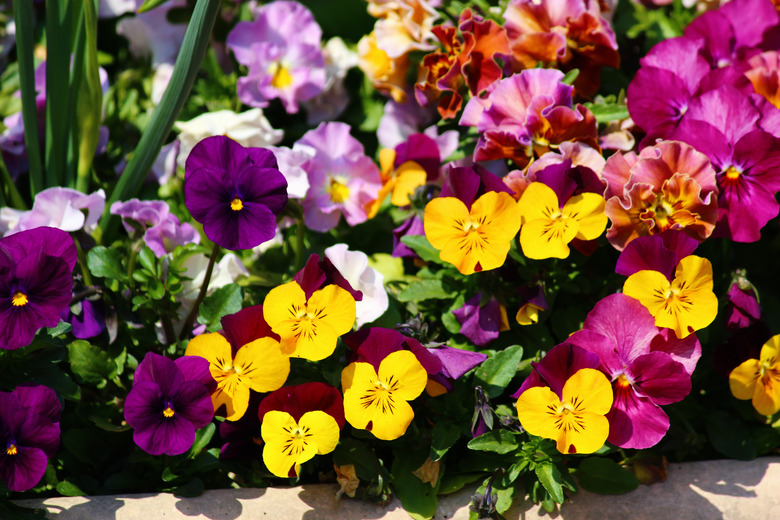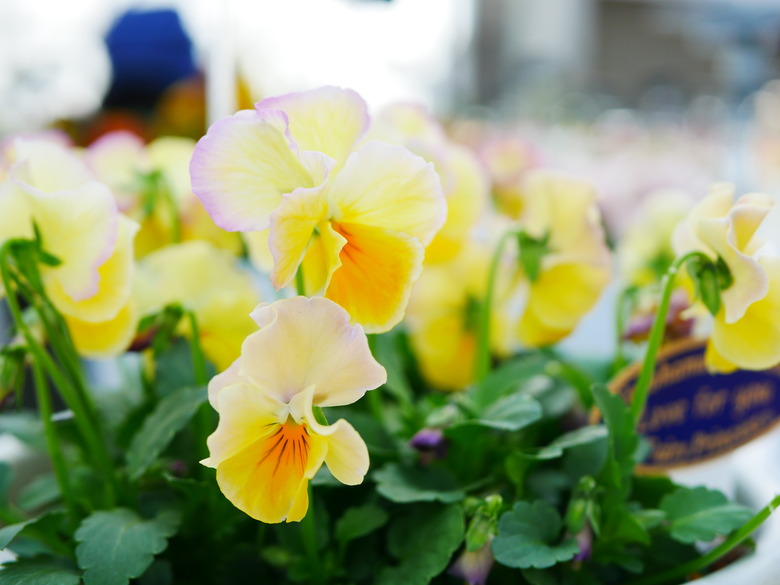How To Grow Pansies
We may receive a commission on purchases made from links.
If you're looking to add an easy burst of color to your garden, pansies (Viola x wittrockiana, USDA zones 6-10) are the flowers for you. With heart-shaped petals in shades of blue, orange, pink, purple, red and yellow, pansy flowers are super colorful. This cool-season plant often provides this color at just the right time, blossoming early in the spring before other plants get going and doing so again in the fall when other plants are fading.
Technically, pansies are very short-lived perennials or biennials. Most gardeners grow them as annuals, however, and consider it a pleasant surprise if a pansy comes back again the next year. Pansies stay a short 6 to 9 inches tall and spread only 9 to 13 inches wide, so you can tuck them almost anywhere you need a vibrant boost.
Planting Pansies in the Garden
Planting Pansies in the Garden
There is no wrong way to use a pansy, so let your imagination run wild. Pansies make great border plants and look nice when they are planted solo or in groups. Pansy groups look nice when each flower is the same color, but a rainbow menagerie works just as well if you prefer.
One strategy is to plant pansies around perennials that bloom in the summer rather than the spring. Your pansies will flower early to provide attractive color, and your perennials will kick in as the summer heat starts to make your pansies fade. Some gardeners prefer to plant pansies with daffodils and other bulbs that flower early for a wide variety of colors and textures in the spring garden.
Where Do Pansies Grow Best?
Where Do Pansies Grow Best?
Pansies will grow heartily in USDA zones 2 through 9 as annuals and in zones 6 through 10 as biennials, tending to perform better in cooler zones than in warmer ones. Preferring daytime temperatures around 60 degrees and nighttime temperatures around 40 degrees, pansies often go dormant during warm summers and experience a resurgence in the fall.
Although they like full sun, pansies in zone 7 and warmer often need a bit of shade. Ideally, your plants will receive lots of early morning sun followed by afternoon shade. In the southernmost parts of the United States, pansies may perform as sort of backward perennials, thriving in the mild winter and going dormant during the summer heat.
When Should You Plant Pansies?
When Should You Plant Pansies?
You can plant pansies in the spring or in the fall. Many gardeners plant their pansies as soon as they can work the ground in early spring. After enjoying them for a few weeks, they then cut back the pansies so they can save water during the intense summer heat. The plants should come back again in the fall before dying off in the winter.
In areas with very mild winters, you can plant pansies in the winter, let them go dormant during the summer heat and then enjoy your plant's return in the fall. This is a great way to stretch a single plant across two growing seasons.
Starting Pansies From Seed
Starting Pansies From Seed
Some gardeners feel pansies are easy to start from seeds, but others find the resulting plants a little finicky. They also take a long time to mature, potentially depriving you of their beautiful blooms if they take too long to get going in the spring. To solve this problem, start seeds indoors 10 to 12 weeks before the last anticipated frost in your area.
Press the seeds about 1/6 inch into the soil, water them and then set the seeds in a dark area where the temperature is about 70 degrees Fahrenheit, keeping the soil moist. When they germinate in about 14 days, move them to a place where they'll get sunlight. As planting time approaches, begin setting your seedlings outside for a few hours at a time to get them acclimated to the outdoors.
Transplanting Pansy Seedlings
Transplanting Pansy Seedlings
For instant garden color, many gardeners prefer to plant pansy seedlings rather than seeds. You can plant young pansies as soon as the soil temperature reaches 45 degrees, even if you still expect frost in your area. These hardy plants will shake off a frost and keep on going as long as it's not a hard, killing freeze.
Begin planting by working some compost into the soil to a depth of about 4 inches. Dig planting holes large enough to accommodate the plant's roots, set the plant in the hole and backfill. You should ideally space your pansies about 7 to 12 inches apart, but some gardeners use them as a ground cover and plant them closer together. Water your young plants into their new home and then mulch around them.
Caring for Pansies
Caring for Pansies
Pansies like light, loamy soil and don't mind if the soil is slightly acidic. They also like lots of sun, but as cool-weather plants, they sometimes find too much sunshine a bit overbearing. Whenever possible, plant your pansies where they'll get lots of morning sun but some protective afternoon shade. Afternoon shade is particularly important in zones 7 and warmer.
Pansies need about an inch of water per week during their growing season. If yours seem to be struggling, try giving them a bit more water. Providing too little water is one of the most common mistakes gardeners make when learning to grow pansies.
Compost worked into the soil at planting time is more than adequate for pansies. There is no need for more fertilizing, and if you do, your plants may get too much nitrogen and produce lots of leaves rather than flowers.
Keeping Your Pansies Flowering
Keeping Your Pansies Flowering
To keep your pansies flowering for as long as possible, deadhead spent blooms. Do this by following the stem beneath the flower and cutting it off cleanly where the flower stem meets the leaves. When summer's heat reaches its peak, you may notice that your pansies stop flowering and start to look wilted or tired. If so, trim them back close to ground level; they'll usually pop back up again in the fall when things cool down.
Pansies work very well in containers, but you'll want to set those containers outside to keep the plants flowering. Flowerpots and containers should be at least 9 inches deep to accommodate the plants' roots. Most homes are too warm and dry for pansies, which thrive in cool weather. You can start pansy seeds indoors, but you'll want to transplant your seedlings or move their containers outdoors for the growing season.
Monitoring for Pests and Problems
Monitoring for Pests and Problems
Snails and aphids commonly visit pansies, as do slugs, which seem to love them. If you grow pansies, slugs are probably going to show up. An effective and natural way to be rid of pests like slugs and snails is to sprinkle some diatomaceous earth around the base of your plants.
Aphids are also easy to handle. Simply blast them off with your garden hose when their numbers grow too large or spray your plant with insecticidal soap.
Diagnosing Viral Diseases
Pansies often grow without issue, but there are several leaf diseases that can strike them. Mosaic viruses give leaves a mottled, discolored appearance that almost makes them look variegated. It comes from contaminated seeds, so only purchase your seeds or seedlings from reputable sources.
If you see this on your plants, remove them from the garden immediately to control the spread. Remove any remaining pansies and garden debris in late fall, as mosaic viruses can overwinter in leaves and other plant matter, and there's no cure for it once it infects plants. Start fresh with new pansies next spring or fall.
Preventing Fungal Infections
Preventing Fungal Infections
Pansies are also susceptible to both downy and powdery mildew. Powdery mildew makes it look as though you've sprinkled white flour all over your plants. Downy mildew causes the leaves to turn yellow or gray, usually following the leaf's veining pattern. One section of the leaf may look normal, whereas the one next to it may have a yellow hue.
You can treat both mildews with an application of fungicide. You can also help prevent them by leaving space around your plants for air circulation and exercising caution when watering. Your irrigation efforts should direct water to the base of the plant rather than watering it from overhead and wetting the plant's leaves.
Gray mold can also occur in pansies. This particular fungus is airborne and attacks the petals of the plant first, causing white or gray spots on the flower petals that appear waterlogged. If left untreated, gray mold will progress and kill its host plant. Like downy mildew and powdery mildew, gray mold is best controlled with good garden practices and fungicide.
If you notice reddish spots on your pansies, they've likely developed a rust. Circular spots with purple borders, however, are likely spot anthracnose. Treat rust with a fungicide containing sulfur and opt for chlorothalonil or mancozeb when treating for anthracnose.
Pansies can also suffer from root rot or crown rot. These rots are often the result of overwatering or poorly draining soil, so cut back on your watering if you see black or mushy areas appearing on your plant. Unfortunately, there is no cure for rots once they take hold – all you can do is reduce your watering and hope for the best. If you can, try cutting away any rotting roots and repot in fresh potting mix or a well-drained location in the garden.


